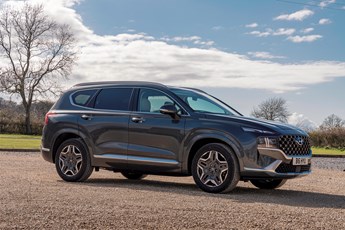
The start point for the best source of fleet information |
First drive: Hyundai Santa Fe
Date: 27 July 2021 | Author: Sean Keywood

|
|
||||||||||||||||||
When a carmaker facelifts one of its models, we usually expect the changes to be as the name suggests - mostly styling tweaks, with perhaps some new engines or new bits of tech also added to help keep things fresh. With the latest Hyundai Santa Fe, however, we need to think less in terms of cosmetic surgery and more a full-blown transplant, because even though the fourth-generation version of Hyundai's largest SUV only arrived three years ago, it's now been shifted on to a whole new platform.
This allows substantive changes such as an all-round increase in cabin size, now wider, longer and taller overall. In particular, Hyundai highlights a 34mm increase in second row legroom, and there is indeed plenty of space for regular rear seat passengers. In addition to this, the Santa Fe remains a seven-seater as standard, meaning a big dollop of extra usability for large families, although the third row of seating would be too cramped for adults for anything but the shortest trips due to a lack of foot space beneath the boot floor - it'll mostly be suitable for children only. Boot space is up to 571 litres with the third-row seats folded - a 24-litre increase - and can hit 1,649 litres with the second-row seats also dropped, although these figures are still down on rivals such as the Skoda Kodiaq and Peugeot 5008.
As for the more usual exterior styling changes we'd expect from a facelift, these come in the form of a new-look front grille and headlights, newly-connected tail lights, and redesigned front and rear bumpers. Inside, a redesigned dashboard features a standard 10.25in infotainment screen - up from 8in with the previous model. Beneath the screen there's a big clump of buttons that initially looks a little overwhelming, but this is deceptive since it contains not only audio and climate controls, but also gear selection buttons and a dial for the selectable drive modes.
The top-spec Ultimate grade tested here also features a high-quality 12.3in digital instrument cluster, which we've previously been impressed by in other Hyundais, in particular with the blind spot view monitor, which replaces the dials with rear three-quarter camera shots when the indicators are switched on, to help with manoeuvring. Our test car's spec also includes an optional Luxury pack, upgrading the interior with Nappa leather trim, suede headliner, brushed aluminium centre console accents, and a faux leather-wrapped dashboard, which all adds a slice of premium appeal.
Hyundai claims the Santa Fe's new platform allows improvements to its aerodynamics, collision safety, and handling. Despite the latter point, given its large size, you still wouldn't expect the model to excel on a twisty road, but it's not too bad - body roll isn't out of control, and despite woolly uncommunicative steering, there are no dramas. Still, it feels far more at home wafting up a motorway, with impressive ride quality and refinement making it a fine tool for covering long distances in comfort.
Until recently, a big SUV like this would have been diesel-powered for sure, but the new Santa Fe is bang on trend for 2021 with no diesel engines at all in the range. Instead, there's a choice of conventional hybrid or plug-in hybrid powertrains, with the former tested here with four-wheel drive (two-wheel drive is also available). On the plus side, with 230hp on offer, this powertrain has easily enough oomph for a big SUV and performance is not at all lacking, delivering fairly brisk acceleration up to motorway speeds. Refinement is also good, and the transitions between petrol and electric running are well managed. However, in contrast to the expected eco-friendliness of hybrid cars, in the spec tested here there's a big problem from a fleet perspective, in the form of official CO2 emissions of 168g/km - enough to put the Santa Fe into the top 37% BIK company car tax bracket. Dropping from Ultimate to Premium spec cuts official emissions to 159g/km (35% BIK), and opting for the two-wheel drive version drops the figure as low as 145g/km (33%), which is rather more palatable and a course of action we'd expect most drivers to pursue with this powertrain. However, it's surely the plug-in hybrid Santa Fe, with official emissions of just 37g/km, which will end up commanding the majority of fleet interest.
Hyundai Santa Fe Ultimate Hybrid 1.6 T-GDi
P11D: £45,230
Residual value: 41.8%
Depreciation: £26,319
Fuel: £9,017
Service, maintenance and repair: £2,669
Cost per mile: 63.34p
Fuel consumption: 38.2mpg
CO2 (BIK %): 168g/km (37%)
BIK 20/40% a month: £279/£558
Luggage capacity: 571 litres (third-row seats folded)
Engine size/power: 1,598cc/180hp plus 60hp electric motor
Verdict |
7/10 |
|||
 |
|
 |
|
|










